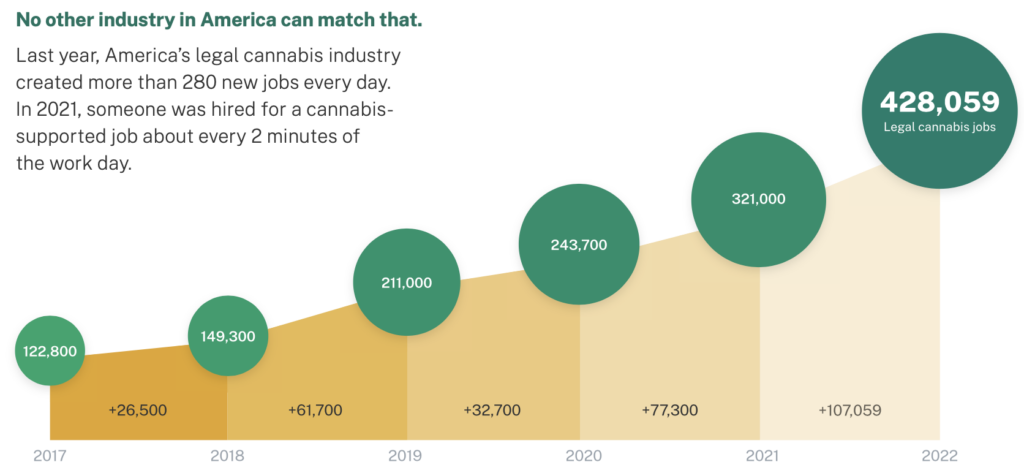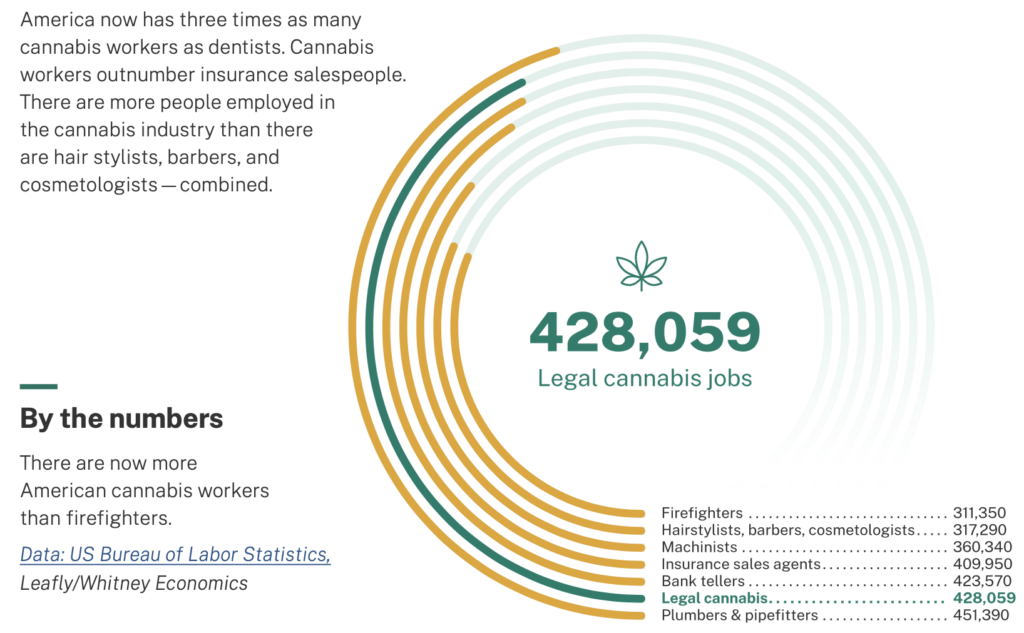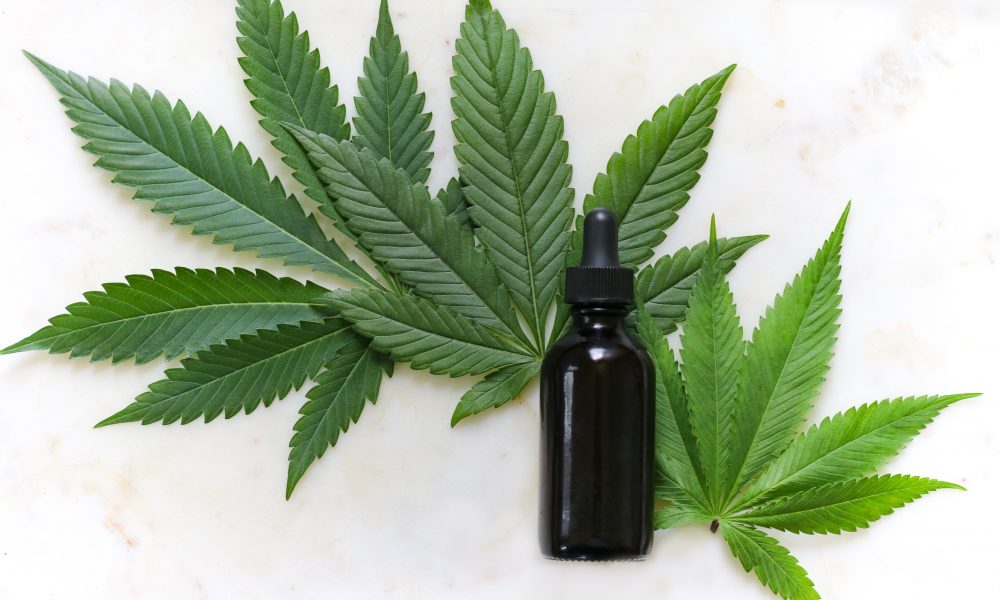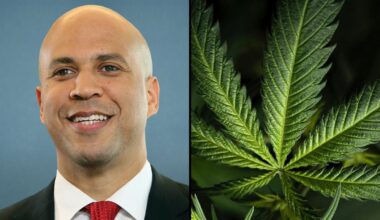The marijuana industry in the U.S. continued to grow in 2021, with almost half a million people now employed full-time in the cannabis sector as more state markets come online and mature, according to a report released by Leafly on Wednesday.
That growth is expected to continue exponentially as states like New York, New Jersey and Connecticut prepare to implement retail sales. But the new figures for 2021 are already sizable, especially considering the ongoing challenges businesses have faced amid the coronavirus pandemic.
Last year was the first time that job creation in the marijuana industry exceeded six figures, with 107,059 new jobs created, compared to 32,700 in 2019 and 77,300 in 2020.
As of 2021, there are 428,059 people employed in the marijuana space, compared to 321,000 the prior year.

Via Leafly.
This is the sixth jobs report that Leafly has put out, and it was created in partnership with the cannabis economic analysis firm Whitney Economics. Researchers further found that adult-use and medical state markets saw about $25 billion worth of cannabis products sold last year, exceeding 2020’s total by nearly $6 billion.
The report emphasizes that marijuana industry growth is far outpacing those of other traditional markets. Last year marked the fifth consecutive year that job growth exceeded 27 percent. By contrast, general business and financial occupations are only expected to grow by about eight percent this decade ending 2030.
But like other sectors of the economy, job shortages and unfulfilled positions remain obstacles to expansion in the marijuana industry. And as Leafly pointed out, the pending retail implementation in several key states means employers will need to do even more hiring to meet consumer demand.
(On a related note, a Wells Fargo analyst recently said that job shortages in the trucking industry are largely attributable to federal prohibition and policies mandating THC drug testing for federally contracted drivers.)
America’s cannabis industry now supports 428,059 full-time jobs. That’s a 33% increase in jobs in a single year. And it marks the 5th year in a row of annual jobs growth greater than 27%. Read more: https://t.co/6bg4TzGG2Q #LeaflyJobsReport #CannabisJobsCount pic.twitter.com/fB71aH7b4x
— Leafly (@Leafly) February 23, 2022
“Since 2014, when the nation’s first adult-use cannabis stores opened, the industry has created hundreds of thousands of new American jobs–and there are still plenty more yet to be created,” Leafly CEO Yoko Miyashita said in a press release. “We know the potential cannabis has as both an economic driver and force for good, and it’s heartening to see employment numbers continue to reflect this strong growth.”
“Leafly is proud to step up and fill the gap created by a lack of federal reporting, and to advocate for federal legalization that’s equitable and accessible to all communities. During this midterm election year, it’s essential our elected officials recognize the reality that cannabis is a leading, homegrown American industry, and help us achieve our goal of an inclusive and profitable cannabis industry for all.”
The new report also projects that total employment in the country’s marijuana market will eventually reach up to 1.75 million workers.
It additionally makes some interesting observations for further context on the size of the marijuana market as of 2021. For example, the analysts note that there are now three times as many people working in cannabis as there are dentists.
There are also more marijuana jobs than there are people working as hair stylists, barbers and cosmetologists combined.

Via Leafly.
Last year’s national cannabis sales figure ($25 billion) is just about 25 percent of the industry’s potential, the report says. It also projects that cannabis revenue is expected to almost double by 2025, and even then it would be “less than half of the total potential market.”
“Last year, America’s legal cannabis industry created more than 280 new jobs every day,” it says. Put differently, a person was hired for a marijuana-related job every two minutes of the work day, on average.
These figures might sounds spectacular, but recent data on marijuana sales, tax revenue and job creation in various state markets supports the report’s overarching point: the industry is here to stay and is continuing to expand.
For example, nearly one out of every 10 jobs that were created in Missouri last year came from the state’s medical marijuana industry, according to a recent analysis of state labor data from a trade group.
The governor of New York has emphasized that marijuana legalization will generate “thousands and thousands of jobs” in the state. Gov. Kathy Hochul’s (D) new budget also estimated that the state stands to generate more than $1.25 billion in marijuana tax revenue over the next six years.
Colorado broke another marijuana sales record in 2021, with state officials reporting over $2.22 billion in cannabis purchases last year. Nearly $500 million of cannabis tax revenue in Colorado has supported the state’s public school system. The state brought in a record $423 million in marijuana tax dollars last year alone.
Meanwhile, Massachusetts is officially collecting more tax revenue from marijuana than alcohol, state data released last month shows. As of December 2021, the state took in $51.3 million from alcohol taxes and $74.2 million from cannabis at the halfway point of the fiscal year. Overall, Massachusetts has seen $2.54 billion in adult-use marijuana purchases since the market came online in November 2018. Regulators first reported that the state achieved the $2 billion sales milestone in September.
Illinois also saw cannabis taxes beat out booze for the first time last year, with the state collecting about $100 million more from adult-use marijuana than alcohol during 2021.
In Arizona, officials reported that retailers in the state sold more than $1.4 billion worth of legal marijuana products in 2021, the first year of recreational sales.
States that have legalized marijuana have collectively garnered more than $10 billion in cannabis tax revenue since the first licensed sales started in 2014, according to a report released by the Marijuana Policy Project (MPP) last month.
U.S. Supreme Court Asks Feds To Weigh In On Medical Marijuana Workers Compensation Cases
Medical Disclaimer:
The information provided in these blog posts is intended for general informational and educational purposes only. It is not a substitute for professional medical advice, diagnosis, or treatment. Always seek the advice of your physician or other qualified healthcare provider with any questions you may have regarding a medical condition. The use of any information provided in these blog posts is solely at your own risk. The authors and the website do not recommend or endorse any specific products, treatments, or procedures mentioned. Reliance on any information in these blog posts is solely at your own discretion.







